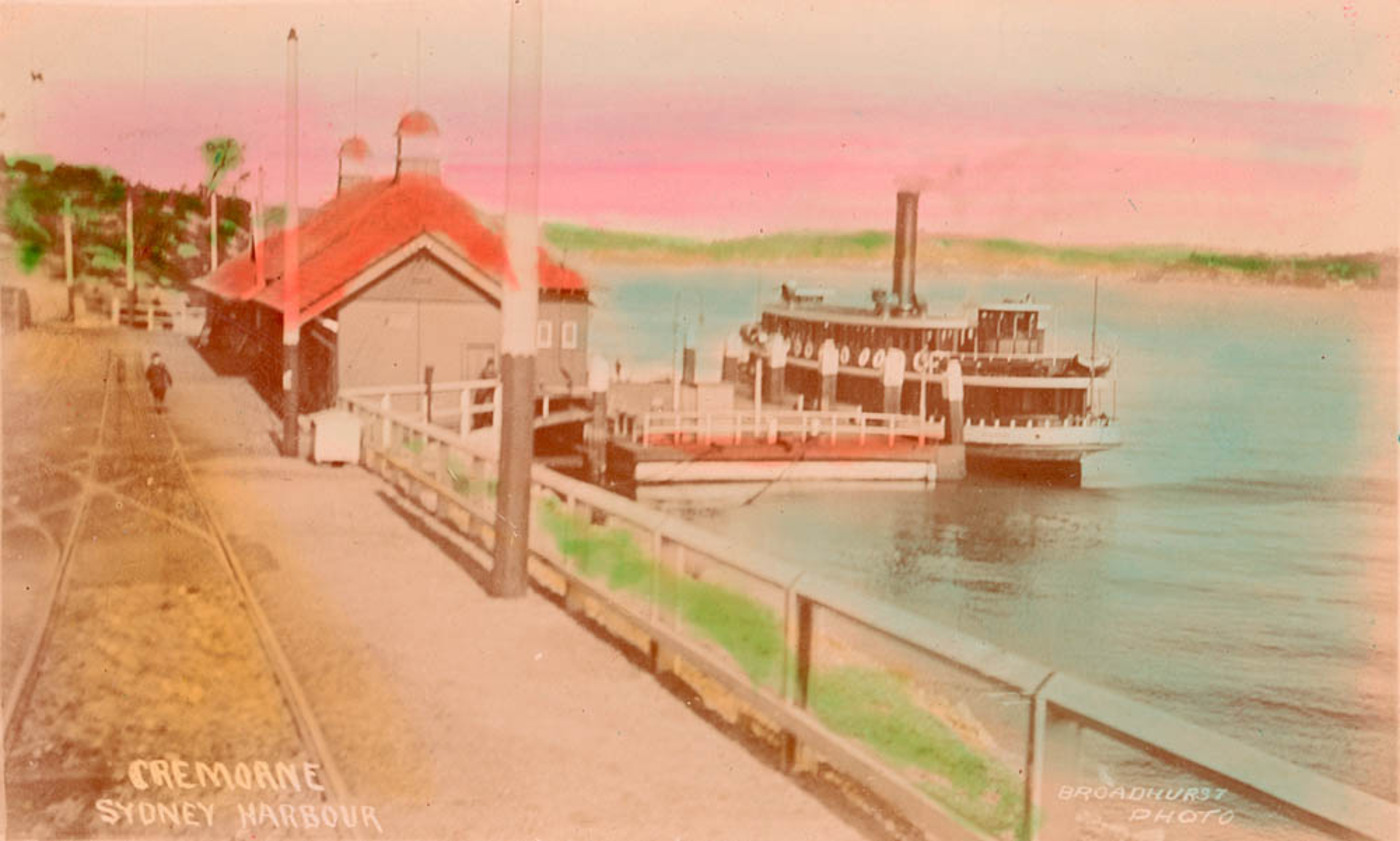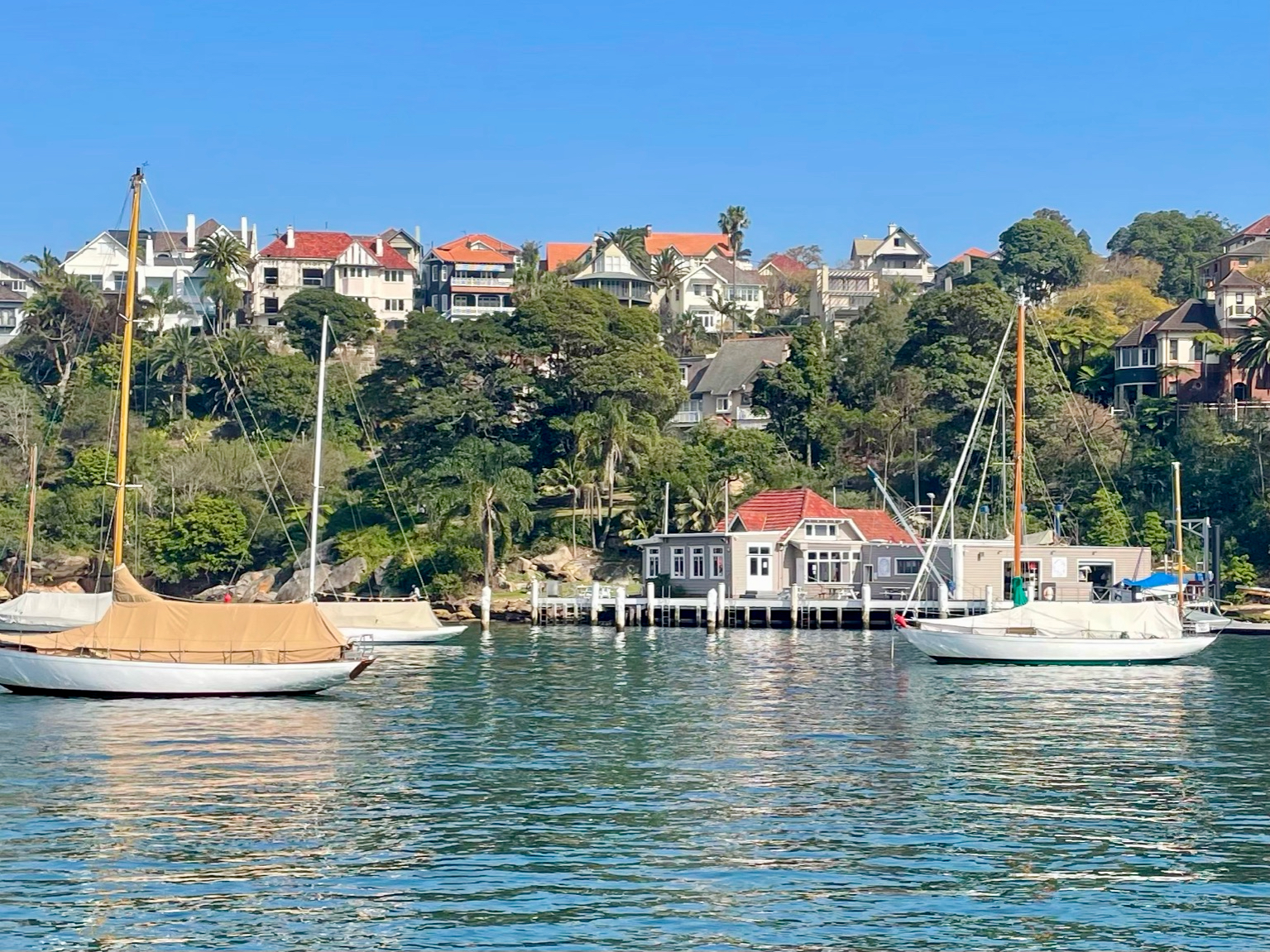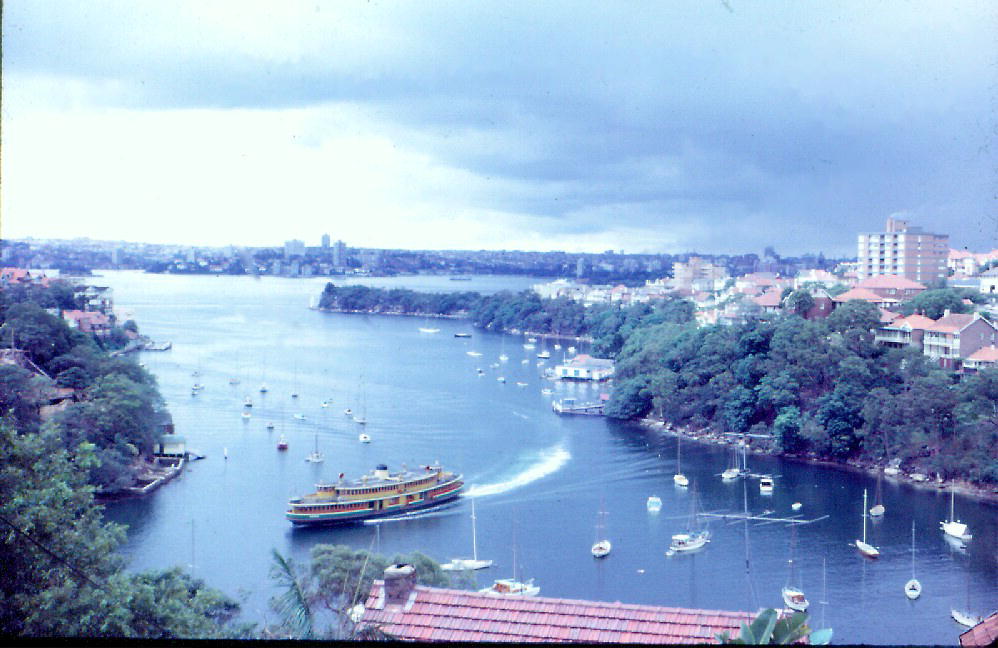|
Old Cremorne Ferry Wharf
Old Cremorne ferry wharf is located on the northern side of Sydney Harbour serving the Sydney suburb of Cremorne. Old Cremorne Wharf, in Mosman Bay on the eastern side of Cremorne Point, was built in the nineteenth century, before the 1911 opening of Cremorne Point Wharf with tram connection on the western end of the Point. The original wharf was at the current location of the Sydney Amateur Sailing Club, but was relocated slightly north to its current location before 1905. The wharf has no road access and is only accessible by foot along the Cremorne Point Reserve path. Services Old Cremorne wharf is served by Sydney Ferries Mosman Bay services operated by First Fleet class ferries. Historical gallery File:Old Cremorne Wharf and K class ferry Mosman Bay 1905.jpg, A then new K-class ferry at the wharf, 1905. File:Sydney Ferry Kurraba.jpg, '' Kurraba'' approaches the wharf en route to Circular Quay, 1909 File:Kirawa & Kanangra passing in Mosman Bay c.1938mosman. ... [...More Info...] [...Related Items...] OR: [Wikipedia] [Google] [Baidu] |
Cremorne Point, New South Wales
Cremorne Point is a harbourside suburb on the Lower North Shore of Sydney, New South Wales, Australia. Cremorne is located 6 kilometres north of the Sydney central business district, in the local government area of North Sydney Council. Cremorne Point shares the postcode of 2090 with Cremorne, a separate suburb to the north. Cremorne Point sits on Sydney Harbour between Shell Cove and Mosman Bay. Cremorne Junction is a locality within the suburb of Cremorne. Etymology Cremorne was named after the Cremorne Gardens in London, a popular pleasure ground in England, which derives from Gaelic words meaning 'boundary' and 'chieftain'. Robertsons Point was named after James Robertson who was granted 35 hectares there in 1820. He was the father of Premier Sir John Robertson. History Wooloorigang / Cremorne Point and Mosman Bay were both once Cammeraygal territory named Wul-warra-Jeung before European settlement in Sydney Cove to their south. Aborigines called the waters east of the ... [...More Info...] [...Related Items...] OR: [Wikipedia] [Google] [Baidu] |
Cremorne Point Ferry Wharf
Cremorne Point ferry wharf is located on the northern side of Sydney Harbour serving the Sydney suburb of Cremorne Point. It is served by Sydney Ferries Mosman services operated by First Fleet class ferries. In June 2007, the wharf sank during a storm. It reopened in September 2007. On 8 October 2014, the wharf closed for a rebuild. The existing wharf was demolished, with a new one built reopening on 5 February 2015. Services Interchanges Keolis Downer Northern Beaches Keolis Downer Northern Beaches is a bus operator in Sydney, Australia. A subsidiary of Keolis Downer, it operates services in Sydney Bus Region 8 on the Lower North Shore and Northern Beaches under contract to Transport for NSW. Its headquar ... operates one route to and from Cremorne Point wharf: *225: to Neutral Bay wharf References External links Cremorne Point Wharfat Transport for New South Wales (Archive11 June 2019Cremorne Point Local Area MapTransport for NSW {{Transport for New South Wa ... [...More Info...] [...Related Items...] OR: [Wikipedia] [Google] [Baidu] |
Kamiri
''Kameruka'' and ''Kamiri'' were near identical ferries that served on Sydney Harbour. ''Kamiri'' was built in 1912 and ''Kameruka'' was launched on 8 February 1913. They were double-ended " K-class" steam ferries, a type that was prolific on Sydney Harbour in the early 20th century boom in cross-Sydney Harbour ferry transport before the 1932 opening of the Sydney Harbour Bridge. ''Kamiri'' was laid up in 1951 following the New South Wales government take-over of the Sydney Ferries Limited. ''Kameruka'' was converted to diesel in 1954 and was laid up in 1984. Both ferries were part of a Sydney Ferries Limited tradition of naming their "K-class" ferries with Australian Aboriginal words beginning with "K". "Kamiri" is the name of an Aboriginal tribe and "Kameruka" is thought to mean 'wait til I come'. Design and construction Both were timber vessels built by Morrison & Sinclair Ltd in Balmain. ''Kamiri'' was built in 1912 and used the engine and timbers from the ferry ''Kaludah ... [...More Info...] [...Related Items...] OR: [Wikipedia] [Google] [Baidu] |
Kurraba And Kirribilli
''Kurraba'' and ''Kirribilli'' were two similar "Sydney K-class ferries, K-class" ferries on Sydney Harbour. Launched in 1899 and 1900 respectively, the two timber-hulled steamers were built for Sydney Ferries Limited during the boom in cross-harbour ferry travel prior to the opening of the Sydney Harbour Bridge. When built, they were the largest of the cross-harbour ferries and brought new levels of comfort for passengers. They were the first true examples of what would come to be known as the "K-class" ferries - a group of 25 double deck, double-ended, predominantly timber-hulled (four later versions had steel hulls), screw ferries propelled by triple expansion steam engines. Built for, and initially used on, the short but busy cross-harbour route between Circular Quay and Milsons Point, New South Wales, Milsons Point, they were also used frequently on the Mosman, New South Wales, Mosman route. Along with 17 others, the two ferries were sold for breaking up in 1934 following th ... [...More Info...] [...Related Items...] OR: [Wikipedia] [Google] [Baidu] |
Sydney K-class Ferry
The K-class ferries were a group of double-ended screw steam ferries run by Sydney Ferries Limited and its government successors on Sydney Harbour. The company introduced more than two dozen of the vessels from the 1890s through to the early twentieth century to meet the booming demand for ferry services across Sydney Harbour prior to the opening of the Sydney Harbour Bridge in 1932. The K-names were largely Australian Aboriginal names with their meanings listed in the table below. Design The K-class were not a group of identical ferries - they were delivered in batches of two or three identical sister ships - rather they were a general type of vessel that ranged in sized but shared a typical form. They were all double-deck, double-ended screw steamers with two raised wheelhouses and a single tall funnel. Apart from a few early vessels with open upper decks that were later enclosed, the K-class had enclosed upper and lower saloons with lower deck outdoor seating around the vessel ... [...More Info...] [...Related Items...] OR: [Wikipedia] [Google] [Baidu] |
First Fleet-class Ferry
The First Fleet class is a class of ferry operated by Transdev Sydney Ferries on Sydney Harbour. History In the early 1980s, the Urban Transit Authority ordered nine catamaran ferries from Carrington Slipways, Tomago. They were to replace the '' K-class'' and wooden ''Lady'' class ferries on Sydney Harbour. The new vessels were named after ships of the First Fleet and were delivered between 1984 and 1986. It was originally intended that they would operate services on the Parramatta River, but they generated too much wash. In 2006/07, the class were repowered with MTU Series 60 engines. Today, all nine remain in service with Transdev Sydney Ferries. In 2020, the then 35-year old ferries underwent a major facelift to provide them with another 10 years of service. The work was undertaken at Port Macquarie. The changes included engines, refurbished interiors, the provision of air conditioning and additional safety features. The first vessel to be upgraded and returned to service ... [...More Info...] [...Related Items...] OR: [Wikipedia] [Google] [Baidu] |
Mosman Bay Ferry Services
The Mosman Bay ferry service (numbered F6) is a commuter ferry route in Sydney, New South Wales, Australia. Part of the Sydney Ferries network, it serves several Lower North Shore suburbs around Mosman Bay. Services begin on the southern side of Sydney Harbour at Circular Quay, then head northeast to the Cremorne Point wharf. Proceeding around Robertsons Point, ferries travel up Mosman Bay to the terminus. Services operate every half an hour on weekdays and every hour at night and on weekends. Wharves Circular Quay Circular Quay wharf is located at the northern end of the Sydney central business district. The locality of Circular Quay is a major Sydney transport hub, with a large ferry, heavy rail, light rail and bus interchange. Cremorne Point Cremorne Point ferry wharf is located at the end of Milson Road, at the southern end of Cremorne Point. It consists of a single wharf. The wharf was extensively damaged during a storm in June 2007. It reopened in September 2007. ... [...More Info...] [...Related Items...] OR: [Wikipedia] [Google] [Baidu] |
Sydney Ferries
Sydney Ferries is the public transport ferry network serving the city of Sydney, New South Wales. Services operate on Sydney Harbour and the connecting Parramatta River. The network is controlled by the New South Wales Government's transport authority, Transport for NSW, and is part of the authority's Opal ticketing system. In 2017–18, 15.3 million passenger journeys were made on the network. Services are operated under contract by Transdev Sydney Ferries. Sydney Ferries Corporation is the state government agency that owns the ferry fleet. History Early services Sydney's ferry services can trace their general origins as far back as the arrival of the First Fleet at Sydney Cove where in 1789, a small boat provided a link between Sydney Cove and the farming settlement of Parramatta. The first vessel, officially named the ''Rose Hill Packet'' (otherwise known as 'The Lump'), was a hoy crafted by convicts and powered by sails and oars. Return trips between Sydney Cove to Parr ... [...More Info...] [...Related Items...] OR: [Wikipedia] [Google] [Baidu] |
Sydney Amateur Sailing Club
The Sydney Amateur Sailing Club (SASC) is one of the oldest sailing clubs in Australia and is located on Sydney's lower north shore, with its clubhouse on the western edge of Mosman Bay. Establishment The Sydney Amateur Sailing Club was founded on 1 October 1872, starting with four boats and twelve members. It was formed in response by owners whose boats were too small (less than ) to be admitted into the existing yacht clubs. The inaugural commodore was J. H. Amora and the vice commodore was W. Backhouse. The first event held by the club was on 30 November 1872 in Sydney harbour, with eight boats in the fleet. The initial meetings of the club were held at the Oxford Hotel. The first competitive races were held on the main harbour in early 1873. Clubhouse The original clubhouse was located at Bennelong Point, now the location of the Sydney Opera House. The club acquired the current clubhouse in August 1962 and this is situated at Cremorne Point. Upon European settlement in 1 ... [...More Info...] [...Related Items...] OR: [Wikipedia] [Google] [Baidu] |
Cremorne Point
Cremorne Point is a harbourside suburb on the Lower North Shore of Sydney, New South Wales, Australia. Cremorne is located 6 kilometres north of the Sydney central business district, in the local government area of North Sydney Council. Cremorne Point shares the postcode of 2090 with Cremorne, a separate suburb to the north. Cremorne Point sits on Sydney Harbour between Shell Cove and Mosman Bay. Cremorne Junction is a locality within the suburb of Cremorne. Etymology Cremorne was named after the Cremorne Gardens in London, a popular pleasure ground in England, which derives from Gaelic words meaning 'boundary' and 'chieftain'. Robertsons Point was named after James Robertson who was granted 35 hectares there in 1820. He was the father of Premier Sir John Robertson. History Wooloorigang / Cremorne Point and Mosman Bay were both once Cammeraygal territory named Wul-warra-Jeung before European settlement in Sydney Cove to their south. Aborigines called the waters east of ... [...More Info...] [...Related Items...] OR: [Wikipedia] [Google] [Baidu] |
New South Wales
) , nickname = , image_map = New South Wales in Australia.svg , map_caption = Location of New South Wales in AustraliaCoordinates: , subdivision_type = Country , subdivision_name = Australia , established_title = Before federation , established_date = Colony of New South Wales , established_title2 = Establishment , established_date2 = 26 January 1788 , established_title3 = Responsible government , established_date3 = 6 June 1856 , established_title4 = Federation , established_date4 = 1 January 1901 , named_for = Wales , demonym = , capital = Sydney , largest_city = capital , coordinates = , admin_center = 128 local government areas , admin_center_type = Administration , leader_title1 = Monarch , leader_name1 = Charles III , leader_title2 = Governor , leader_name2 = Margaret Beazley , leader_title3 = Premier , leader_name3 = Dominic Perrottet (Liberal) , national_representation = Parliament of Australia , national_representation_type1 = Senat ... [...More Info...] [...Related Items...] OR: [Wikipedia] [Google] [Baidu] |
Mosman Bay
Mosman Bay is a bay of Sydney Harbour adjacent to the suburb of Mosman, 4 km north-east of the Sydney CBD in New South Wales, Australia. Three ferry wharves, Mosman Bay, South Mosman and Old Cremorne, are within the bay, all being served by the F6 Mosman Bay ferry service. History Originally known as Great Sirius Cove, this name lives on in the next bay to the east, Sirius Cove (originally Little Sirius Cove). The bay was originally so named after Governor Arthur Phillip's flagship and only defence of the colony, , which was refitted in the Bay in 1789, the second year of the colony's existence. In 1831, the bay's current namesake, Archibald Mosman, obtained a land grant for the area surrounding the bay. Together with his twin brother George, Mosman founded a whaling station within Mosman Bay. Substantial buildings and stone quaywork were erected. The quaywork remains (incorporated into later seawalls) as does the Old Barn, a sandstone building now used as a Scout ha ... [...More Info...] [...Related Items...] OR: [Wikipedia] [Google] [Baidu] |







